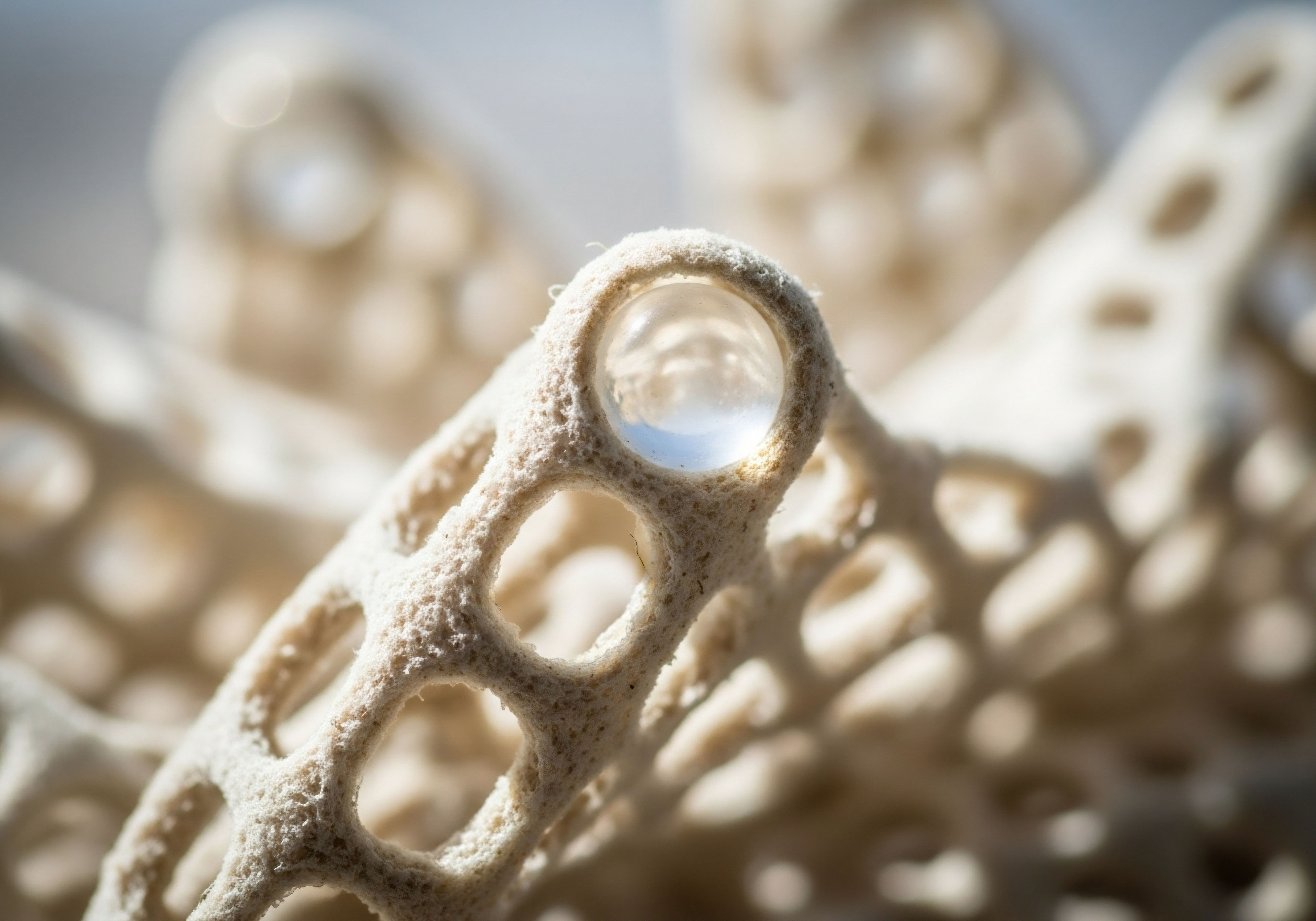

Fundamentals
Your skeletal framework feels like a permanent, unchanging part of you. It is the structure that carries you through life, a silent partner in every action. The lived experience of bone health, for many, is one of quiet confidence until a fracture, a diagnosis, or the subtle stoop of a loved one brings its fragility into sharp focus.
Understanding the intricate biological dialogue that maintains this structure is the first step toward preserving its strength. This dialogue is conducted in the language of hormones, and one of the most eloquent speakers in this conversation is an enzyme named aromatase. Its function is essential for skeletal integrity in every human body, yet its operational context and significance are distinctly different between the sexes.
At its core, aromatase is a biological translator. It is an enzyme that facilitates the conversion of androgens ∞ hormones typically associated with male characteristics, such as testosterone ∞ into estrogens. In the female body before menopause, the ovaries are the primary factories for estrogen, producing it in abundance to regulate the reproductive cycle and influence tissues throughout the body, including bone.
After menopause, as ovarian function wanes, the role of aromatase becomes far more significant for women, as it converts androgens from the adrenal glands and other sources into a baseline supply of estrogen. This process occurs in various tissues, including adipose (fat) tissue and bone itself.

The Male Skeleton’s Reliance on Estrogen
The biological arrangement in the male body is quite different and provides a clear window into the universal importance of estrogen. Men produce testosterone in large quantities from the testes. A significant portion of this testosterone is then converted into estrogen by aromatase, not in a single location, but throughout the body in tissues like fat, brain, and critically, within bone cells.
This locally produced estrogen is the dominant hormonal signal responsible for maintaining bone density in men. It is the key that locks the gate on excessive bone breakdown and supports the construction of new bone tissue. The male skeleton, therefore, is profoundly dependent on this elegant conversion process. Without sufficient aromatase activity, a man’s bones would be unable to properly utilize his abundant testosterone for their own preservation.
Estrogen, derived from testosterone by the enzyme aromatase, is the principal hormone responsible for skeletal maintenance in men.
This fundamental difference in hormonal strategy ∞ direct ovarian production in pre-menopausal women versus continuous, distributed conversion in men ∞ is the starting point for understanding the differential impacts on bone health. Both sexes require estrogen for strong bones. The pathway to acquiring that estrogen, however, defines their unique vulnerabilities and responses to aging and clinical interventions.
A woman’s bone health is dramatically affected by the event of menopause, a rapid decline in estrogen production. A man’s bone health is more gradually influenced by age-related declines in testosterone and potential shifts in aromatase activity, often linked to changes in body composition.
The story of aromatase and bone is a compelling example of biological resourcefulness. The body uses one hormone as the raw material for another, ensuring that a critical function like skeletal maintenance is supported through different physiological contexts. Recognizing this shared dependency on estrogen, while appreciating the different routes of its supply, moves our understanding toward a more complete and clinically useful picture of bone health across the human lifespan.


Intermediate
To appreciate the clinical significance of aromatase in skeletal health, we must first understand the process of bone remodeling. Your bones are in a constant state of renewal, managed by two specialized cell types ∞ osteoclasts, which break down old bone tissue, and osteoblasts, which build new bone tissue.
Healthy skeletal maintenance depends on a balanced equilibrium between this resorption and formation. Estrogen is a master regulator of this balance. Its primary role is to restrain the activity and lifespan of the osteoclasts. When estrogen levels are adequate, bone breakdown is kept in check, allowing bone formation to keep pace.
When estrogen levels fall, osteoclasts become more numerous and active, leading to a net loss of bone mass over time. This is the central mechanism behind post-menopausal osteoporosis in women and a key factor in age-related bone loss in men.

How Do Clinical Protocols Modulate Aromatase for Male Health?
In clinical practice, particularly in male hormone optimization, managing aromatase activity is a central therapeutic goal. Men undergoing Testosterone Replacement Therapy (TRT) receive exogenous testosterone to restore physiological levels. This increase in testosterone provides more raw material for the aromatase enzyme, which can lead to a concurrent rise in estrogen levels.
While some of this conversion is necessary for bone health and other functions, excessive aromatization can cause undesirable side effects. Therefore, protocols often include an aromatase inhibitor (AI) like Anastrozole.
The use of Anastrozole in this context is a delicate balancing act. The objective is to moderate the conversion of testosterone to estrogen, preventing levels from becoming supraphysiological while preserving enough estrogen to maintain skeletal integrity. Over-inhibition of aromatase can be detrimental, effectively depriving the bones of the very estrogen they need for protection.
Laboratory testing is essential to guide dosing, monitoring both testosterone and estradiol (the primary estrogen) levels to ensure they remain within an optimal range. This clinical application directly demonstrates the differential impact ∞ in men on TRT, aromatase activity is a variable that must be actively managed to secure the benefits of testosterone for the skeleton.
Clinical management of male hormonal health often involves modulating aromatase to balance the benefits of testosterone with the necessity of estrogen for bone preservation.
In women, the therapeutic use of aromatase inhibitors is starkly different and highlights the enzyme’s critical role. AIs are a cornerstone of treatment for estrogen receptor-positive (ER+) breast cancer in post-menopausal women. By blocking the aromatase enzyme, these drugs drastically reduce the body’s production of estrogen, starving cancer cells of the hormone that fuels their growth.
This life-saving intervention, however, has a predictable and significant consequence for the skeleton. By systemically shutting down estrogen synthesis, AIs remove the primary protective signal for bone, leading to accelerated bone loss and a heightened risk of fractures. Women on AI therapy require diligent bone density monitoring and often need additional treatments specifically to counteract this effect.
This table illustrates the distinct hormonal environments and their relationship to bone health in different life stages and clinical scenarios.
| Group | Primary Source of Estrogen | Typical Aromatase Role | Primary Skeletal Concern |
|---|---|---|---|
| Pre-Menopausal Women | Ovaries | Secondary to ovarian production | Achieving peak bone mass |
| Post-Menopausal Women | Aromatization of adrenal androgens in peripheral tissues | Primary source of endogenous estrogen | Accelerated bone loss due to estrogen deficiency |
| Men | Aromatization of testicular testosterone in peripheral tissues | Primary and continuous source of estrogen | Age-related bone loss from declining testosterone/estrogen |
| Men on TRT with AI | Aromatization of exogenous testosterone | Modulated to control estrogen levels | Potential for bone loss if aromatase is over-inhibited |
| Women on AI Therapy | Pharmacologically blocked | Target of therapeutic inhibition | Medically induced, rapid bone loss |
The following list outlines the specific, well-established functions of estrogen in maintaining a healthy skeleton, underscoring why its presence, via aromatase or otherwise, is so vital.
- Regulation of Pubertal Growth ∞ Estrogen is responsible for the pubertal growth spurt and the eventual fusion of the epiphyseal growth plates in the long bones of both boys and girls, which ceases longitudinal growth.
- Restraint of Bone Remodeling ∞ It directly suppresses the formation of new osteoclasts and induces apoptosis (programmed cell death) in existing ones, thereby reducing the rate of bone resorption.
- Support for Osteoblasts ∞ Estrogen promotes the survival and activity of osteoblasts, the cells responsible for synthesizing new bone matrix.
- Modulation of Inflammatory Signals ∞ It can reduce the production of certain inflammatory cytokines in the bone marrow that are known to stimulate osteoclast activity.
Understanding these intermediate mechanisms reveals a clear picture. The differential impact of aromatase activity in men and women is a function of its context. In men, it is a continuous, vital process for lifelong bone maintenance. In post-menopausal women, it provides a baseline level of essential estrogen. In clinical settings, its modulation can be a tool for health or a source of skeletal risk, depending entirely on the therapeutic goal.


Academic
A sophisticated analysis of aromatase’s role in bone metabolism requires moving beyond systemic hormone levels to consider the molecular and genetic factors that govern its function. The enzyme itself is encoded by a single gene, CYP19A1. The expression of this gene is a highly complex process, regulated by different tissue-specific promoters.
This allows for fine-tuned control of estrogen synthesis in diverse locations like gonads, adipose tissue, brain, and bone itself. The local, or paracrine, production of estrogen within the bone microenvironment is a critical concept for understanding its physiological impact. The estrogen synthesized by osteoblasts and other local cells acts directly on neighboring cells, achieving high functional concentrations at the site of action that may not be reflected in circulating serum levels.

What Are the Genetic Determinants of Aromatase Expression in Skeletal Tissue?
Inter-individual variability in bone health has a significant genetic component, and polymorphisms within the CYP19A1 gene are an important piece of this puzzle. Single nucleotide polymorphisms (SNPs) are variations at a single position in a DNA sequence. Certain SNPs in the CYP19A1 gene have been associated with differences in aromatase activity, circulating estrogen levels, and consequently, skeletal outcomes.
For instance, studies have identified specific genetic variants that correlate with higher lifetime estrogen levels and, as a result, greater bone mineral density (BMD) and reduced fracture risk in both elderly men and postmenopausal women. This suggests that an individual’s genetic predisposition for higher or lower aromatase efficiency can be a lifelong determinant of their skeletal resilience.
The interaction between these genetic factors and other variables, like body composition, is also significant. Adipose tissue is a major site of extragonadal aromatization. In men, a higher fat mass can contribute to higher circulating estrogen levels, which may be protective for bone. The skeletal consequences of specific CYP19A1 genotypes appear to be modulated by an individual’s amount of fat mass, illustrating a complex gene-environment interaction that influences the hormonal regulation of bone.
Genetic polymorphisms in the CYP19A1 gene create inter-individual differences in aromatase efficiency, which directly influence bone mineral density and fracture risk.
The following table provides examples of how genetic factors and local synthesis contribute to the nuanced control of bone health.
| Factor | Mechanism | Significance in Men | Significance in Women |
|---|---|---|---|
| CYP19A1 Polymorphisms | Allelic variations lead to higher or lower intrinsic aromatase activity. | Correlates with variations in BMD and fracture risk, modulated by fat mass. | Associated with differences in BMD and risk for estrogen-related conditions. |
| Paracrine Synthesis | Estrogen is produced by bone cells (osteoblasts, osteocytes) for local action. | A primary source of the estrogen that directly regulates local bone remodeling. | Contributes to local bone maintenance, especially after menopause when ovarian sources cease. |
| Estrogen Receptor Alpha (ERα) | The primary receptor mediating estrogen’s effects on bone cells. | Essential for closing growth plates and suppressing osteoclast activity. A man with a non-functioning ERα receptor presented with unfused epiphyses and severe osteoporosis despite high estrogen levels. | Mediates estrogen’s protective effects on the female skeleton throughout life. |
| Biphasic Dose-Response | Low estrogen levels may stimulate bone formation, while very high levels may have different effects. | Physiologically normal male estrogen levels appear optimal for stimulating periosteal apposition (bone widening). | Higher estrogen levels in puberty and adulthood are primarily inhibitory to longitudinal bone growth after plate fusion. |

What Is the Biphasic Estrogen Effect on Bone Geometry?
The influence of estrogen on the skeleton extends beyond density to affect bone geometry. There is evidence for a biphasic, dose-dependent effect of estrogen on the periosteum, the outer surface of bone responsible for its width.
At the lower concentrations typically found in men and in early pubertal girls, estrogen appears to stimulate periosteal apposition, leading to an increase in bone diameter. This is a biomechanically favorable adaptation, as wider bones are more resistant to bending forces.
Conversely, the higher estrogen concentrations seen in late puberty and throughout adult life in women may inhibit this cross-sectional growth. This differential effect on bone geometry is another subtle but important distinction in how estrogen, and therefore aromatase activity, shapes the male and female skeleton differently over a lifetime.
This deepens our appreciation for the system’s elegance. The differential impact is not simply about the presence or absence of a hormone. It is about concentration gradients, genetic predispositions, local versus systemic action, and effects on both the density and the physical architecture of bone.
Both sexes require estrogen for skeletal health, a fact established by clinical models of complete estrogen deficiency or resistance. The physiological variations in how they achieve and respond to this estrogen, governed by the intricate regulation of aromatase, define their unique skeletal journeys.
The advanced understanding of these mechanisms has direct translational value. For example, identifying individuals with high-risk CYP19A1 genotypes could inform personalized screening strategies for osteoporosis. In designing hormonal therapies for men, the goal is to replicate the optimal physiological balance of androgens and estrogens, a balance that is itself influenced by an individual’s unique genetic makeup.
This academic perspective transforms our view from a simple hormonal comparison into a systems-biology problem, where genetics, metabolism, and local cellular signaling converge to determine skeletal outcomes.

References
- Vanderschueren, D. et al. “Aromatase Activity and Bone Loss in Men.” Journal of Clinical Endocrinology and Metabolism, vol. 97, no. 3, 2012, pp. E413-E423.
- Khosla, S. et al. “Aromatase Activity and Bone Homeostasis in Men.” The Journal of Clinical Endocrinology & Metabolism, vol. 91, no. 3, 2006, pp. 837-41.
- Lucas, Doug. “Estrogen Blockers & Bone Health ∞ What Many Women Need to Know.” YouTube, 22 July 2025.
- Cauley, Jane A. “Estrogen and bone health in men and women.” Bone, vol. 80, 2015, pp. 60-65.
- Gubbels, Bu-Bu, et al. “Understanding Sex Differences in Autoimmune Diseases ∞ Immunologic Mechanisms.” International Journal of Molecular Sciences, vol. 25, no. 13, 2024, p. 7101.
- Finkelstein, J. S. et al. “Gonadal steroids and body composition, strength, and sexual function in men.” New England Journal of Medicine, vol. 369, no. 11, 2013, pp. 1011-1022.
- Adler, R. A. “The effects of testosterone on bone.” Clinical Endocrinology, vol. 82, no. 5, 2015, pp. 718-723.

Reflection
The information presented here provides a map of the complex biological landscape governing your skeletal health. It reveals the shared dependency on a single hormone, estrogen, and the distinct paths the male and female bodies take to secure it.
This knowledge shifts the perspective on bone health from a passive state of being to an active, dynamic process that you can understand and support. Your body is a system of profound intelligence, constantly adapting and communicating through these intricate hormonal pathways.
Consider your own health journey. How does understanding this internal architecture change the way you view your body’s signals and symptoms? The biological narrative of aromatase is one of translation, conversion, and balance. It invites a deeper curiosity about your own unique physiology. This understanding is the foundation. The next step is a personalized conversation, guided by clinical expertise, to translate this knowledge into a proactive strategy for your lifelong vitality and structural resilience.



